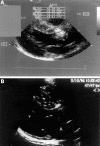Echocardiographic features of Candida species endocarditis: 12 cases and a review of published reports
- PMID: 11454836
- PMCID: PMC1729846
- DOI: 10.1136/heart.86.2.179
Echocardiographic features of Candida species endocarditis: 12 cases and a review of published reports
Abstract
Objective: To describe the specific echocardiographic features of Candida species endocarditis.
Design: Retrospective review of the case records of patients with confirmed candida endocarditis.
Setting: Cases referred to three French university centres over an eight year period were studied.
Design: 12 patients with confirmed Candida species endocarditis infection were identified. The transthoracic (n = 12) and transoesophageal (n = 12) echocardiographic appearances were compared with the surgical findings (n = 10).
Results: Large dense heterogeneous vegetations were found in 11/12 cases. A hyperechogenic heterogeneous myocardial texture, observed in seven of the 12 patients, was associated with extensive myocardial damage at surgery. While it was possible to diagnose candidal cardiac infection in all patients by transthoracic echocardiography, transoesophageal echocardiography was useful for optimal assessment of the valvar and paravalvar structures.
Conclusions: In the setting of endocarditis, the detection of myocardial involvement, which is characterised by a heterogeneous myocardial texture, is an argument in favour of Candida species endocarditis and may warrant early surgical intervention.
Figures


References
Publication types
MeSH terms
LinkOut - more resources
Full Text Sources
Medical
